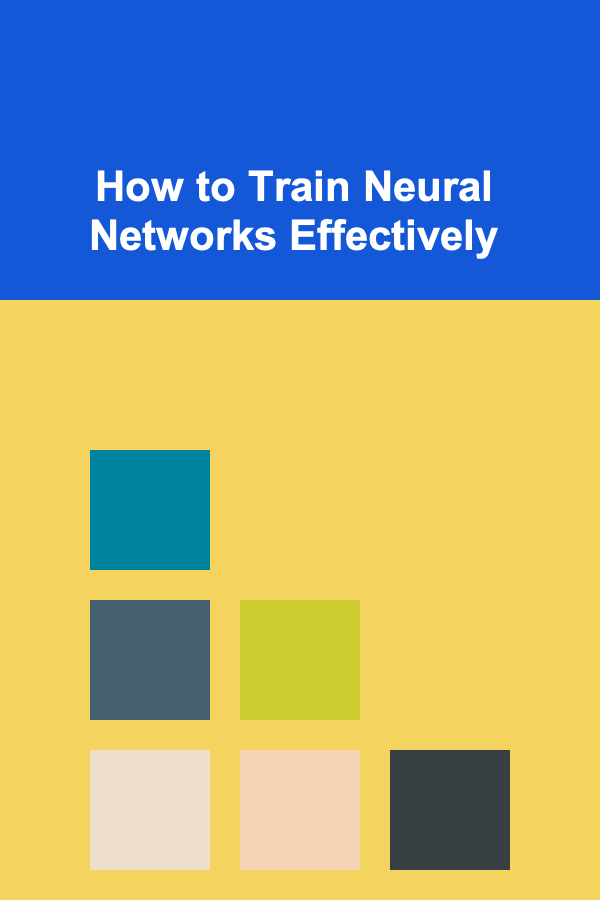
How to Train Neural Networks Effectively
ebook include PDF & Audio bundle (Micro Guide)
$12.99$7.99
Limited Time Offer! Order within the next:

Training neural networks has become one of the core practices in the field of machine learning and artificial intelligence. From image recognition to natural language processing and even autonomous driving, neural networks power many of the most groundbreaking innovations in the modern world. However, as with any machine learning model, effective training is essential for achieving optimal performance. In this article, we will explore the strategies and techniques used to train neural networks effectively, addressing challenges, tools, and advanced techniques to maximize performance.
Introduction to Neural Networks
Neural networks are computational models inspired by the human brain, designed to recognize patterns and make decisions based on data. A typical neural network consists of layers of neurons (or nodes) connected by weights. These models are structured into input layers, hidden layers, and output layers. The neurons process the input data through activation functions, which help determine the network's output.
The Importance of Effective Training
Training a neural network is about finding the optimal set of weights that allows the model to make predictions with minimal error. However, the training process can be fraught with challenges, such as overfitting, underfitting, and slow convergence. Effective training helps to mitigate these issues and ensures that the model generalizes well to unseen data, making it an essential part of building machine learning systems.
Understanding the Components of Neural Network Training
To train neural networks effectively, it's important to understand the various components involved in the training process. These include the following key elements:
2.1. Data Preparation
Data is the foundation of any machine learning model, and neural networks are no exception. Proper data preparation can significantly improve the training process.
Data Preprocessing
- Normalization and Standardization: Neural networks often perform better when data is normalized (scaled to a specific range, such as [0, 1]) or standardized (rescaled to have a mean of 0 and a standard deviation of 1). This helps ensure that the learning process is smooth and prevents any feature from dominating the learning process.
- Handling Missing Data: Incomplete data can lead to poor model performance. Techniques like imputation (replacing missing values with the mean, median, or mode) or even removing data points with missing values are common solutions.
- Data Augmentation: In fields like image processing, data augmentation is a technique that artificially increases the size of a dataset by applying transformations like rotation, scaling, and flipping to existing data. This helps improve the robustness of the model.
2.2. Model Architecture
Selecting the right architecture is crucial for the performance of neural networks. Different tasks and data types require different types of neural networks:
- Feedforward Neural Networks (FNNs): The simplest type of neural network where information flows in one direction from input to output.
- Convolutional Neural Networks (CNNs): Typically used in image processing, CNNs use convolutional layers to detect spatial hierarchies in data.
- Recurrent Neural Networks (RNNs): Best suited for sequential data like text or time-series data, where the network retains memory of previous inputs.
- Generative Adversarial Networks (GANs): A network that pits two models (a generator and a discriminator) against each other, often used for data generation tasks.
Choosing the right architecture requires understanding the task at hand, the type of data you're working with, and the computational resources available.
2.3. Loss Function
The loss function measures how well the neural network's predictions match the expected outcomes. During training, the objective is to minimize the loss function.
- Mean Squared Error (MSE): Common for regression tasks, where the difference between the predicted value and the actual value is squared.
- Cross-Entropy Loss: Used for classification tasks, especially when the output is categorical. It quantifies the difference between the true labels and predicted probabilities.
The choice of loss function can have a significant impact on how effectively the neural network learns from the data.
2.4. Optimization Algorithm
Optimization algorithms adjust the weights of the neural network to minimize the loss function. The most commonly used optimization algorithm is stochastic gradient descent (SGD), but there are several variations, each with its strengths:
- Stochastic Gradient Descent (SGD): Updates weights incrementally using a small random subset of the data, which can make it computationally efficient but prone to local minima.
- Adam Optimizer: A more advanced optimization algorithm that adapts the learning rate for each parameter, improving convergence speed and performance, especially for complex models.
Choosing the right optimizer is important for faster convergence and better overall performance.
Training Techniques
Training a neural network is a complex process that involves adjusting various hyperparameters and monitoring model performance. Below are some of the most effective training techniques:
3.1. Batch vs. Stochastic Gradient Descent
In gradient descent, the optimizer adjusts the weights based on the loss function's gradient. The main difference between batch gradient descent, mini-batch gradient descent, and stochastic gradient descent lies in how the data is used:
- Batch Gradient Descent: Uses the entire dataset to compute gradients and update weights. It can be computationally expensive but provides a more stable convergence path.
- Stochastic Gradient Descent (SGD): Updates weights based on one data point at a time, making it faster but more prone to fluctuations in the optimization process.
- Mini-Batch Gradient Descent: A compromise between batch and stochastic gradient descent, where a small subset of data (mini-batch) is used to compute gradients. This offers a good balance of speed and stability.
3.2. Learning Rate Scheduling
The learning rate determines how much the weights are adjusted after each update. A high learning rate can lead to unstable training, while a low learning rate can result in slow convergence. Effective learning rate scheduling can help balance these trade-offs.
- Learning Rate Decay: Gradually reducing the learning rate during training can help the model converge more effectively, especially after the model has learned the basic patterns in the data.
- Cyclical Learning Rates: A technique where the learning rate is varied periodically between a minimum and maximum value. This can help the model escape local minima and explore a broader solution space.
3.3. Regularization
Regularization techniques are used to prevent the model from overfitting to the training data and generalize better to unseen data.
- L1 and L2 Regularization: L1 regularization adds a penalty based on the absolute value of the weights, while L2 regularization penalizes the sum of squared weights. L2 regularization is commonly known as weight decay and helps in reducing large weights that may lead to overfitting.
- Dropout: A technique that randomly sets a fraction of the neurons to zero during training, forcing the network to learn more robust features and reducing overfitting.
- Early Stopping: Monitoring the model's performance on a validation set and stopping training when the performance starts to degrade helps prevent overfitting.
3.4. Data Shuffling and Cross-Validation
To ensure that the model learns from a diverse set of data and does not overfit to any specific subset, it's important to shuffle the data before training. Cross-validation further helps by splitting the dataset into multiple folds, training the model on some folds and testing it on others, which ensures the model generalizes well.
Hyperparameter Tuning
Hyperparameters, such as the learning rate, batch size, number of hidden layers, and number of neurons per layer, significantly affect the performance of a neural network. The process of finding the optimal combination of hyperparameters is known as hyperparameter tuning.
4.1. Grid Search
Grid search involves manually specifying a range of values for each hyperparameter and then training the model on every combination of those values. While exhaustive, it can be computationally expensive.
4.2. Random Search
In random search, hyperparameters are randomly sampled from a predefined search space. It is computationally less expensive than grid search and can sometimes find better hyperparameter combinations.
4.3. Bayesian Optimization
Bayesian optimization uses probabilistic models to intelligently choose hyperparameters, aiming to find the best hyperparameter settings with fewer evaluations. This technique is particularly useful for high-cost function evaluations, such as deep learning models.
Challenges in Training Neural Networks
Training neural networks comes with several challenges, which can significantly affect performance:
5.1. Overfitting and Underfitting
- Overfitting occurs when the model becomes too complex and performs well on the training data but fails to generalize to unseen data. Techniques like regularization, dropout, and early stopping can help mitigate overfitting.
- Underfitting occurs when the model is too simple and fails to capture the underlying patterns in the data. This can be addressed by increasing the complexity of the model or using more features.
5.2. Vanishing and Exploding Gradients
In deep neural networks, gradients can either become very small (vanishing gradients) or very large (exploding gradients), causing the training to become unstable or extremely slow. Techniques like gradient clipping and using activation functions like ReLU (Rectified Linear Unit) can help alleviate this problem.
5.3. Computational Resources
Training large neural networks can be computationally intensive, often requiring specialized hardware like Graphics Processing Units (GPUs) or Tensor Processing Units (TPUs). Parallel processing and distributed training frameworks, such as TensorFlow and PyTorch, are commonly used to speed up the training process.
Conclusion
Training neural networks effectively requires a comprehensive understanding of the components involved in the process, including data preprocessing, model architecture, loss functions, optimization algorithms, and regularization techniques. By implementing strategies like learning rate scheduling, hyperparameter tuning, and advanced techniques such as dropout and cross-validation, it's possible to significantly improve the performance and generalization capabilities of neural networks. The challenges of overfitting, underfitting, and computational limitations can be addressed with the right combination of tools and techniques. With careful attention to these factors, neural networks can be trained to perform at their best across a wide range of tasks and applications.

How to Plan a Budget-Friendly Home Party Without Sacrificing Fun
Read More
How to Use Apps to Manage Your Finances
Read More
How to Use Microsoft Word Skills to Make Money
Read More
Monetizing Your Deep Learning Knowledge through Online Courses
Read More
10 To-Do List Items to Prepare for Technical Interviews
Read More
10 Bible Verses for Overcoming Anxiety and Fear
Read MoreOther Products

How to Plan a Budget-Friendly Home Party Without Sacrificing Fun
Read More
How to Use Apps to Manage Your Finances
Read More
How to Use Microsoft Word Skills to Make Money
Read More
Monetizing Your Deep Learning Knowledge through Online Courses
Read More
10 To-Do List Items to Prepare for Technical Interviews
Read More